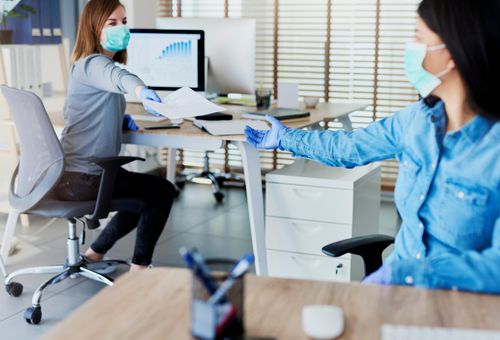
Social distancing also called "physical distancing," means keeping space between yourself and other people. To practice social or physical distancing we are advised to stay at least 6 feet (about 2 arms' length) from other people. The Centers for Disease Control (CDC) recommends avoiding close contact with people who are sick, including anyone that may be sick within your home.
Social Distancing Strategy
In healthcare facilities, social distancing is a must for patients, employees, and visitors. A question we have been asked multiple times is how to ensure employees are socially distancing. Not too long ago, OSHA issued guidance for Social Distancing at Work. As part of their guidance, OSHA recommends implementing the following:
- Encourage workers to stay home if they are sick.
- Isolate any worker who begins to exhibit symptoms until they can either go home or leave to seek medical care.
- Establish flexible worksites (e.g., telecommuting) and flexible work hours (e.g., staggered shifts), if feasible.
- In workplaces where customers are present, mark six-foot distances with floor tape in areas where lines form, and limit the number of customers allowed at one time.
- Stagger breaks and rearrange seating in common break areas to maintain physical distance between workers.
- Move or reposition workstations to create more distance, and install plexiglass partitions.
- Encourage workers to bring any safety and health concerns to the employer's attention.
Managing Visitors
Managing visitors during the COVID-19 pandemic has been difficult for healthcare facilities that generally permit visitors to accompany patients. Prior to COVID-19 being declared a public health emergency, under most circumstances visitors could accompany patients to their appointments. However, due to the risk of transmission of the COVID-19 virus, the CDC is advising healthcare facilities to limit and restrict visitor access to the facility as much as possible. If visitors are allowed, healthcare facilities should consider implementing the following:
- Designate an entrance that visitors can use to access the facility.
- Visitors who are noted by healthcare facility staff to have symptoms consistent with COVID-19 should be instructed to leave the facility and seek care if needed. Similar to patients, visitors should also be screened. See below for Tips for Screening Visitors.
- Posters should be installed that advise visitors (and patients) of signs of acute respiratory illness. These postings should be at the entrance of the facility and advise the visitors to not enter the facility if they have signs and symptoms.
- If visitors are allowed, facilities should follow national, state, and county guidance regarding the use of medical masks or face coverings. Most facilities are requiring face covering or masks to be worn with limited exceptions (e.g., under the age of 2).
- It is recommended only visitors who are essential for helping to provide patient care and/or caring for pediatric patients should be allowed.
What about Waiting Rooms?
Waiting rooms require special attention. According to a recent report, it is estimated there are over close to 884 million ambulatory care visits a year in the United States, with over half of the visits being to primary care facilities. It is also estimated the average wait time is just over 18 minutes from the time of patient arrival to the time the patient sees the provider.
Because of this, we recommend managing how patients and visitors wait in your facility. Any chairs in your waiting room should be at least six feet apart from other patients. We have advised some practices to remove chairs, or if that is not feasible, to place signs or tape across chairs that are not to be used. From there, cleaning and disinfection of the waiting room are extremely important! Magazines and other fomites should be removed, and any surfaces that are frequently touched should be frequently cleaned and disinfected. Also, make sure you have covered trash receptacles, preferably no-touch, that are emptied frequently (make sure whoever empties is wearing appropriate personal protective equipment).
Questions?
Do you have questions about social distancing strategies or visitor policies? If so, please contact us by email: support@hcp.md or by phone at 855-427-0427.
Tips for Screening Visitors
Ask the screening questions or have the visitor complete a screening questionnaire.
Take the individual's temperature.
Allow or deny access based on screening and temperature. If access is denied, recommend that the visitor follow up with their healthcare provider about testing options.
Keep information confidential.
Any written or verbal information obtained during the screening process should be kept confidential.
If you are asking patients or visitors questions related to their health, make sure you are doing this in an area where information cannot be overheard by unauthorized individuals.
Document only the minimum necessary information.
Check with your local health department to determine if there are any reporting or recordkeeping requirements.
In most circumstances, unless you are testing individuals for the COVID-19 virus, you do not have any obligation to report screening results, unless directed by local health authorities.
Download "Tips for Screening Visitors"

